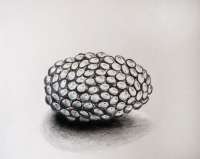AUP - Berliner Künstlerprogramm/ DAAD
Nicole De Brabandere
In 2009 I put in motion the possibility of amassing all of the doorknobs from an institutional building that was slated for demolition. After many phone calls to various authorities I discovered that a contract for the knobs had already been signed by the demolition company and that the only way I could access the knobs was to purchase them at 7$ a piece from the wrecking yard. This monetary constraint put an end to moving forward with the project. However, during the process of trying to gain access to the knobs, I reflected on the physical and conceptual space that they would create when gathered together. The surfaces of the knobs betrayed their decades of use. All but the lustrous convex fronts of the knobs, which had been polished by coming into contact with uncountable palms over the years, were tarnished. This visible residue on the smooth metallic surface revealed the knobs as prosthetic nubs that, for many years, extended the grasp of the human hand; the shiniest part being the point at which they connected most securely to the body. Given the immediacy of using doorknobs and their ubiquitous modesty, I wondered how many people considered the extent to which the ergonomic forms shaped and directed their everyday choreographies, or whether all awareness of grasping and turning the knobs was buried in the unconscious familiarity of habitual action. I reflected on whether the density of all the knobs collected and organized into one form could accumulate decades of bodily movement and physical contact into a resonant intimacy in the present. Although this artistic project was never realized, it set in motion the orientation of my current work, which engages habitual manners, gestures and everyday actions that extend sentience and direct the body as the raw material of artistic production.
For more information, please visit www.nicoledebrabandere.com.
Image Information:
The drawing that I have included shows one possible way in which all of the collected doorknobs from the building could have been assembled.
AUP - Berliner Künstlerprogramm/ DAAD
Nicole De Brabandere
In 2009 I put in motion the possibility of amassing all of the doorknobs from an institutional building that was slated for demolition. After many phone calls to various authorities I discovered that a contract for the knobs had already been signed by the demolition company and that the only way I could access the knobs was to purchase them at 7$ a piece from the wrecking yard. This monetary constraint put an end to moving forward with the project. However, during the process of trying to gain access to the knobs, I reflected on the physical and conceptual space that they would create when gathered together. The surfaces of the knobs betrayed their decades of use. All but the lustrous convex fronts of the knobs, which had been polished by coming into contact with uncountable palms over the years, were tarnished. This visible residue on the smooth metallic surface revealed the knobs as prosthetic nubs that, for many years, extended the grasp of the human hand; the shiniest part being the point at which they connected most securely to the body. Given the immediacy of using doorknobs and their ubiquitous modesty, I wondered how many people considered the extent to which the ergonomic forms shaped and directed their everyday choreographies, or whether all awareness of grasping and turning the knobs was buried in the unconscious familiarity of habitual action. I reflected on whether the density of all the knobs collected and organized into one form could accumulate decades of bodily movement and physical contact into a resonant intimacy in the present. Although this artistic project was never realized, it set in motion the orientation of my current work, which engages habitual manners, gestures and everyday actions that extend sentience and direct the body as the raw material of artistic production.
For more information, please visit www.nicoledebrabandere.com.
Image Information:
The drawing that I have included shows one possible way in which all of the collected doorknobs from the building could have been assembled.
